-
90th Anniversary of Ogawa Shinsuke’s Birth
Narita: Heta Village
- JAPAN / 1973 / Japanese / B&W / 16mm / 146 min
 Director: Ogawa Shinsuke
Director: Ogawa Shinsuke
Photography: Tamura Masaki
Camera Assistants: Kawakami Koichi, Hara Tadashi
Photography, Editing: Ogawa Shinsuke, Fukuda Katsuhiko, Yumoto Mareo, Iwasaki Seiji, Shiraishi Yoko, Nakano Chihiro
Sound: Kubota Yukio
Sound Assistance: Asanuma Yukikazu
Producers: Iizuka Toshio, Tadokoro Naoki, Nosaka Haruo, Fuseya Hiroo, Honma Shusuke, Mikado Sadatoshi
Production Company: Ogawa Productions
Source: The Japan Foundation, The Film School of Tokyo
Ogawa’s Sanrizuka series had heretofore focused on the farmers’ protest actions, whereas this film meticulously documents daily life in Heta Village. While exploring the historical roots of the villagers’ strength to resist, and through long discussions with them about their resistance and its effects, Ogawa Productions masterfully crystallizes the shared sense of time unique to a farming village, which emerges as the film’s central theme. With this work the film unit pivoted in a direction that led them to A Japanese Village—Furuyashikimura (1982), shot in Yamagata, and the Magino Village films.
Born in 1936. Began working as an assistant director at Iwanami Productions in 1960 and formed the Ao no Kai (Blue Group) film study group with Higashi Yoichi, Tsuchimoto Noriaki, Kuroki Kazuo, and others around 1962. He went freelance in 1964 and made his first film, Sea of Youth (1966). He made The Oppressed Students in 1967, founded Ogawa Productions in 1968, and began documenting the movement of farmers in opposition to the construction of Narita International Airport. His films won support at workplaces and universities throughout Japan in the midst of the Zenkyoto student movement. Beginning with Summer in Narita (1968), he lived with the farmers in Sanrizuka as he filmed them, making seven films in the series in total. Next, he and the staff of Ogawa Productions moved to Magino in Yamagata Prefecture, where they made A Japanese Village—Furuyashikimura (1982) and Magino Village—A Tale (1986). His dedicated work as an organizing member of the first YIDFF in 1989 was instrumental to the festival’s success. He passed away on February 7, 1992.
